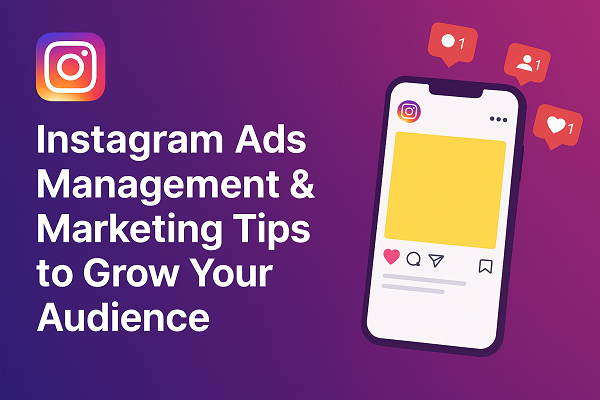Instagram has become one of the most powerful platforms for businesses to reach potential customers. With over 2 billion active users, the platform offers an opportunity to engage with targeted audiences through visually appealing content and paid advertising. Successful Instagram ads management is not just about boosting posts; it’s about creating a strategy that drives real growth.
This context covers key Instagram ad strategies and marketing tips to help grow your audience and improve performance.
What Is Instagram Ads Management?
Instagram ads management involves planning, creating, running, and monitoring ad campaigns on Instagram. It includes selecting objectives, targeting the right audience, designing visuals, writing ad copy, setting budgets, and analyzing results.
When done properly, ads on Instagram can increase brand awareness, generate leads, and drive conversions. Businesses that apply strong ad management principles often see better returns on ad spend.
Benefits of Effective Instagram Ads Management
- Precise audience targeting
- Improved engagement rates
- Better use of ad budgets
- Higher conversion rates
- Detailed performance tracking
Instagram provides advanced tools to target users based on their interests, behaviors, and demographics. By managing ads effectively, brands can focus on users who are more likely to interact and buy.
Types of Instagram Ads You Can Run
A strong Instagram Ads Management plan starts with knowing which ad format fits your goal. Here are the main types:
1. Photo Ads
These are single-image ads that show up in the feed. They’re ideal for showcasing a product or delivering a clear message.
2. Video Ads
Video content is a powerful way to tell a story, explain a product, or show a behind-the-scenes look at your business.
3. Carousel Ads
These ads let users swipe through multiple images or videos. Great for showing different product features or highlighting a collection.
4. Stories Ads
Stories appear at the top of the Instagram app. Full-screen and time-limited, they capture attention quickly and can include links or calls to action.
5. Reel Ads
Short and engaging, Reel Ads help brands reach a younger audience. They feel organic and blend well with user-generated content.
Key Instagram Ads Management Tips to Grow Your Audience
Let’s look at practical ways to improve your Instagram ad strategy and reach more users.
1. Define Clear Goals
Start every campaign with a specific goal. Whether it’s brand awareness, website traffic, app downloads, or sales, choose one objective. Instagram’s Ads Manager allows you to align your campaign with that goal, so performance becomes easier to track.
2. Target the Right Audience
Use Instagram’s targeting tools to choose who sees your ads. You can target based on:
- Age, gender, and location
- Interests and online behavior
- Custom audiences (e.g., people who visited your website)
- Lookalike audiences (users similar to your existing customers)
Accurate targeting improves the effectiveness of your campaigns and helps you reach people who are more likely to follow or engage.
3. Use High-Quality Visuals
Instagram is a visual platform. Your ad image or video must stand out. Use bright colors, clean designs, and images that match your brand style. Avoid clutter. Every visual should stop the scroll and deliver a clear message.
4. Write Strong Captions and CTAs
Your ad caption should be brief, relevant, and focused. Use a call-to-action (CTA) that tells the viewer what to do next: “Shop Now,” “Learn More,” “Send a Message,” etc. A good CTA can increase your click-through rate and boost conversions.
5. Test Different Variations (A/B Testing)
Never rely on one ad version. Test multiple variations of images, videos, headlines, and CTAs. This helps you find out what your audience prefers. Make changes based on performance data.
6. Use Instagram Insights for Better Results
The Instagram Ads Manager provides data on how your ads are performing. Look at metrics like:
- Impressions
- Reach
- Engagement
- Click-through rate
- Cost per result
Use this data to improve future campaigns. Cut what’s not working and invest more in what brings results.
7. Retarget Interested Users
Instagram allows you to retarget users who’ve interacted with your brand. These include people who:
- Visited your website
- Watched your videos
- Engaged with your page
These users are already familiar with your brand, so they’re more likely to convert. Retargeting campaigns can help push them to take the next step.
8. Schedule Ads for Peak Times
Your audience is not online 24/7. Look at your insights to see when your followers are most active. Run ads during those peak times to improve visibility and engagement.
9. Optimize for Mobile Experience
Most users access Instagram on mobile. Make sure your ad content is mobile-friendly—text should be readable, and buttons should be easy to click. Videos should load quickly and look good on small screens.
10. Collaborate with Influencers
Influencer partnerships can boost your ads’ reach and credibility. Consider paid partnerships where the influencer posts content on their feed, supported by paid promotion through Instagram Ads Manager.
How Instagram Ads Management Supports Growth
Done well, Instagram ads management plays a direct role in audience growth. Here’s how:
- Attracts new followers through discovery-based content
- Strengthens brand image by showing consistent, creative posts
- Improves trust with professional, well-crafted ads
- Encourages engagement with interactive formats like Reels and Stories
- Drives action by showing the right message to the right person at the right time
With time, a well-managed ad strategy creates a steady stream of new followers and potential buyers.
Final Thoughts
Running ads on Instagram requires more than just spending money. To grow your audience, you need the right combination of strategy, creativity, and data. Effective Instagram ads management involves planning campaigns, targeting with precision, testing visuals and copy, and improving based on performance.
When you treat ad management as an ongoing process rather than a one-time task, you’re more likely to grow your audience and get better results.
Would you like a downloadable version of this article or help setting up a campaign strategy for your brand?





